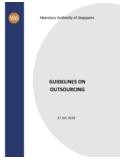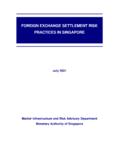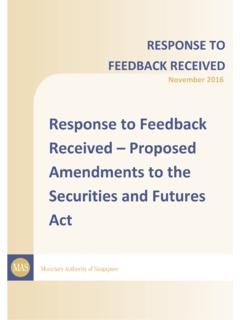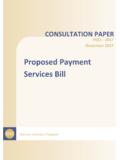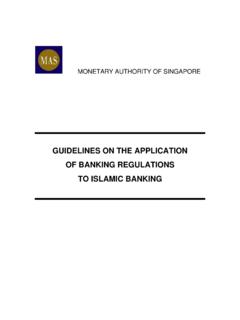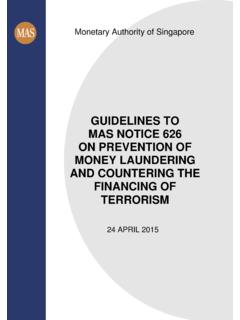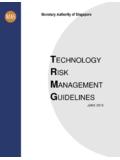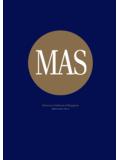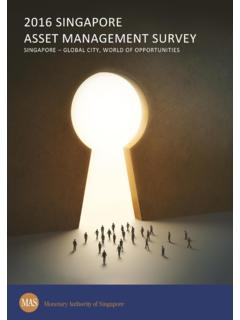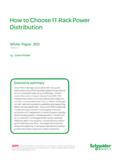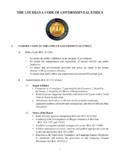Transcription of GUIDELINES ON STANDARDS OF CONDUCT FOR …
1 Monetary Authority of Singapore GUIDELINES ON STANDARDS OF CONDUCT . FOR marketing AND distribution . activities . GUIDELINES on STANDARDS of CONDUCT for marketing and distribution activities 2. Guideline No : FSG-G02. Issue Date : 23 December 2016. GUIDELINES ON STANDARDS OF CONDUCT FOR marketing . AND distribution activities BY FINANCIAL INSTITUTIONS. INTRODUCTION. 1 The Monetary Authority of Singapore ( MAS ) has issued the GUIDELINES on STANDARDS of CONDUCT for marketing and distribution activities ( the GUIDELINES ). to emphasise our expectations for financial institutions and their representatives to CONDUCT their marketing and distribution activities at retailers and public places in a responsible and professional manner. The GUIDELINES apply to all financial institutions which CONDUCT marketing and distribution activities that target retail customers, and the representatives who act on behalf of these financial institutions. 2 Financial institutions today have various marketing and distribution arrangements, such as roadshows and tie-ups with retailers, to market their products and services to customers1.
2 These arrangements increase the reach of financial institutions to members of the public and if not properly managed, may give rise to the following issues: (a) Harassment of customers Customers who are not seeking to purchase financial products and services, may feel harassed or make impulse purchases when they are prospected. Furthermore, they may not be adequately prepared to provide information necessary for a proper sales and advisory session and could face increased risk of buying a product or service that is not suitable for their needs, financial situation or risk profile. (b) Unconducive environment for the purchase of financial products When financial institutions market and sell financial products and services at retailers and public places, it is common for them to set up sales booths in open and visible spaces with high foot traffic. 1. For example, these may include roadshows held at public places such as MRT stations, bus interchanges or shopping malls, and tie-ups with retailers such as supermarket chains or furniture and electrical product retailers.
3 GUIDELINES on STANDARDS of CONDUCT for marketing and distribution activities 3. Under such circumstances, the physical environment may not be conducive for financial institutions to CONDUCT proper sales and advisory sessions. (c) Confusion over the identities and roles of the financial institution and its representatives Where there is a tie-up between a financial institution and a retailer, the sales booths of the financial institution may be located within the premises of the retailer and there may be co-branding efforts between the two parties. In such scenarios, customers may be confused as to whether they are dealing with a representative of the financial institution or staff of the retailer when approached to purchase a financial product or service. When financial institutions CONDUCT marketing and distribution activities in public places or temporary locations, customers may have difficulty identifying the financial institution which the representatives are acting on behalf of.
4 This is because the prospecting activities and sales and advisory sessions are not conducted within the premises of the financial institution and it may not be obvious to customers that the person they are dealing with is from a financial institution. (d) Enticement of customers to purchase unsuitable products Financial institutions often attract customers with gifts when they CONDUCT marketing and distribution activities . Customers may be enticed by these gifts or by bundled promotions offered by financial institutions and the retailers they have tie-ups with, and purchase financial products or services which they may not require or which are not suitable for them. (e) Mishandling of cash and cheques collected Financial institutions may collect payments from customers in the form of cash or cheques for transactions closed at retailers and public places. The mishandling of such payments exposes financial institutions to possible financial losses or fraud.
5 GUIDELINES on STANDARDS of CONDUCT for marketing and distribution activities 4. 3 The GUIDELINES set out safeguards that financial institutions should put in place and adhere to when they market and sell financial products and services to retail customers at retailers and public places. While the safeguards set out in the GUIDELINES are aimed at addressing the market CONDUCT risks arising from marketing and distribution arrangements at retailers and public places, we expect financial institutions to also apply the GUIDELINES to all other activities conducted to market and sell their financial products and services, where relevant. This may include street canvassing, CONDUCT of surveys, door-to-door prospecting and holding seminars where there is also marketing and sale of financial products and services. 4 The GUIDELINES also set out MAS' expectations that the board and senior management of financial institutions are accountable and responsible for ensuring that there are proper controls in place for their financial institution's marketing and distribution activities .
6 5 The GUIDELINES are principles-based. They set out the objectives and intended outcomes of each safeguard. Each financial institution should consider how best to apply and achieve the objectives of the GUIDELINES to suit its business model and customer base. 6 The GUIDELINES should be read with the relevant Acts, and their subsidiary legislation, written directions, notices, codes and other GUIDELINES that MAS may issue from time to time. MAS will take into account a financial institution's ability or failure to observe the GUIDELINES in assessing whether a financial institution or any of its representatives satisfy the business CONDUCT requirements set out in the relevant Acts and subsidiary instruments, and whether they continue to be fit and proper to CONDUCT regulated activities . 7 The GUIDELINES shall take effect on 1 April 2017. GUIDELINES on STANDARDS of CONDUCT for marketing and distribution activities 5. DEFINITION. 8 For the purposes of the GUIDELINES , representative refers to any employee or agent that is engaged by a financial institution to CONDUCT marketing and distribution of financial products and services on its behalf.
7 "customer" includes a prospective customer. 9 The terms used in the GUIDELINES shall, except where expressly defined in the GUIDELINES or the context otherwise requires, have the same meanings as defined in the relevant Acts. GUIDELINES on STANDARDS of CONDUCT for marketing and distribution activities 6. 1 BOARD AND SENIOR MANAGEMENT RESPONSIBILITIES. MAS expects the Board and senior management of financial institutions to set the right tone in conducting marketing and distribution activities to customers in a responsible and professional manner. MAS will also hold the Board and senior management accountable for ensuring that their financial institution's business CONDUCT practices are in line with the objectives of the GUIDELINES . The Board and senior management should ensure that the safeguards elaborated in section 2 are incorporated into the financial institution's policies, systems and processes relating to its marketing and distribution activities , as relevant.
8 They should also ensure that the risks posed by their financial institution's marketing and distribution activities are properly assessed and addressed. Where issues arise that may compromise the interests of customers, the financial institution should consider instituting measures that are more stringent than those set out in the GUIDELINES . GUIDELINES on STANDARDS of CONDUCT for marketing and distribution activities 7. 2 MARKET CONDUCT SAFEGUARDS. Exercising adequate oversight of marketing and distribution activities marketing and distribution activities at retailers and public places increase the reach of financial institutions to members of the public. If such activities are not properly managed, they could lead to heightened market CONDUCT risks to customers. To mitigate these risks, financial institutions should maintain adequate oversight of their marketing and distribution arrangements at these places to ensure that their representatives engage in proper marketing , sales and advisory practices.
9 Financial institutions should carefully assess the potential market CONDUCT risks that could arise and ensure that they devote sufficient resources to, and put in place sound processes for, the oversight of their marketing and distribution arrangements at retailers and public places. These are elaborated in Safeguards 1 to 4. Safeguard 1. Financial institutions should CONDUCT call-backs or surveys for all customers prospected at retailers and public places before or within the free-look or cooling-off period, to ensure that customers have understood their purchases closed at such locations. Financial institutions are expected to implement this safeguard for the sale of life insurance policies 2 , accident and health policies, and collective investment schemes. marketing and distribution arrangements are usually held at public areas or at the premises of retailers with high foot traffic ( roadshows at shopping malls or supermarket chains). Some customers may find it difficult to make a 2.
10 Financial institutions are not expected to implement Safeguard 1 for any sale made with respect to simple life policies sold as an ancillary product to loans with a simple payment basis for the insurance cover. These include policies that cover outstanding loans in relation to personal loans, car loans and credit card balances, but exclude mortgage reducing term assurance plans. GUIDELINES on STANDARDS of CONDUCT for marketing and distribution activities 8. considered decision in such circumstances and could make impulse purchases while being prospected at retailers and public places. The financial institution should CONDUCT call-backs or surveys to customers when its representatives prospect and close sales at retailers and public places to ensure these customers are fully aware of the features and risks of the financial product or service they have bought. This will also enable the financial institution to detect inappropriate CONDUCT such as mis-selling, misrepresentation or pressure selling.
